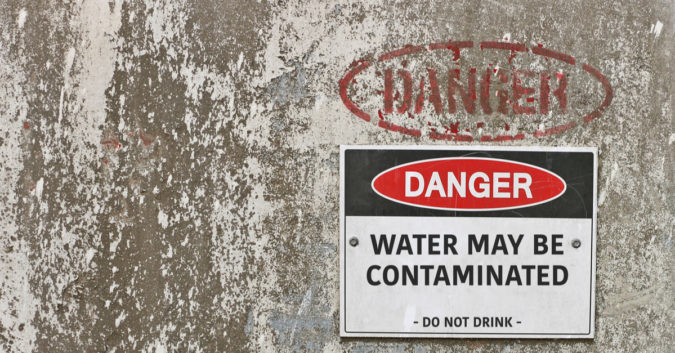A small group of chemicals referred to as “forever chemicals” are increasingly becoming this generation’s poster child for reckless corporate industrial pollution. Like lead in the 1970s and asbestos in the 1980s, we are only now beginning to understand the scope, severity, and lethality of “forever chemicals,” and the outlook is grim.
“Forever Chemicals,” or per- and polyfluoroalkyl substances — “PFAS,” for short — have been in production since the 1940s. Favored for their anti-corrosive properties, they were first used in the Manhattan Project to create protective coatings that could withstand radioactive materials.
After the war, companies like 3M and Dupont began using the compounds in non-stick cookware, stain-resistant fabrics, water-repellent clothing, and firefighting foam. Their use continued well into the 2010s, even though insiders at these corporations knew of their toxicity for decades.
How Widespread Is ‘Forever Chemical’ Contamination?
It’s now estimated that a large majority of Americans have been exposed to PFAS chemicals, which are linked to a variety of serious health problems. They include birth defects, immune problems, hormone disruptions, and cancer.
From a scientific standpoint, so much about these chemicals is still unknown — how exactly they proliferate, at what quantity they become toxic, and whether or not they truly are “forever,” meaning they accumulate in the human body and cannot be broken down. This contrasts with more well-known toxins like lead and asbestos.
Despite the need for more scientific research, existing data paints a clear picture: These chemicals are bad enough that they need to be, at the very least, controlled, and more likely banned altogether. It is partly because contamination points are so varied that the need for regulatory action is so great.
PFAS contamination can come from something as seemingly normal and everyday as cooking breakfast with a non-stick pan, but the risk is more acute in and around factories where PFAS has been used or manufactured.
Dupont, for example, is reported to have dumped more than 1.7 million pounds of a PFOA compound (also known as PFOA or “C8”) into the environment around its plant in Parkersburg, West Virginia between 1951 and 2003.
That environmental tragedy was the subject of the recent Mark Ruffalo film, Dark Waters. (Incidentally, Ruffalo himself has been instrumental in encouraging lawmakers to regulate PFAS, having recently testified before the House Committee on Oversight and Reform.) Other factories and dumpsites in New Jersey and Michigan have been hotbeds for PFAS contamination.
PFAS at U.S. Military Bases
U.S. military sites are other key sources of PFAS exposure. The U.S. Department of Defense (DOD) has identified some 425 military sites in every state but Hawaii where water has been contaminated by PFAS after exercises were conducted involving the use of firefighting foam.
The DOD expects cleanup efforts at these sites to cost well over $2 Billion — a figure that has both alarmed and expedited legislative action.
Last year, Congress introduced a bill that would require the Environmental Protection Agency (EPA) to designate all perfluoroalkyl and polyfluoroalkyl chemicals as “hazardous substances” — a legal term that the Pentagon says is required for it to clean up military sites contaminated with PFAS.
Last month, however, just as Congress seemed ready to move on the issue, negotiations stalled. With bipartisan support for cleaning up military sites, lawmakers still seemed at odds over the regulation of PFAS for industrial purposes. Specifically, Republicans were worried that the bill was too far-reaching in its EPA designation and would saddle utilities with costly compliance burdens.
Amidst Congressional Stall, White House Sides With Industry
The White House has expressed opposition to the bill in its current form, claiming that such regulations…
“…would create considerable litigation risk, set problematic and unreasonable rule-making timelines and precedents, and impose substantial, unwarranted costs on federal, state, and local agencies.”
Democrats say the need to protect drinking water supersedes such concerns, especially when it comes to the safety and viability of the military sites.
“[Republicans] wanted the ability to overrule the no backsliding provision with cost-benefit analysis, so if it just costs utilities too much money, then never mind let’s not do it,” a frustrated Democratic aide told The Hill. “But that’s ridiculous. That’s not protecting anyone, that’s not protecting health, it’s protecting bottom lines.”
Interest in moving on PFAS regulation remains bipartisan, but the scope and power of such a law are in question. Meanwhile, PFAS regulatory advocates are trying to seize this moment to pass a bill that most agree is still fairly modest in detail.
“Congress has a chance to right this wrong,” wrote Scott Faber of the Environmental Working Group (EWG), in an editorial. “Much more needs to be done to notify and test the blood of military veterans who drank contaminated water or handled foams without proper protective gear. But cleaning up legacy PFAS pollution is a crucial first step.”
